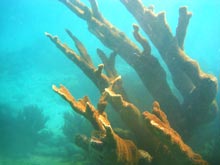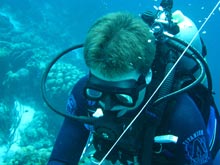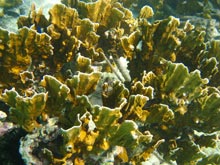Ten Transects Down . . . Only Ten to Go!!
Acropora palmate (elkhorn coral), once prevalent around the island’s leeward coast, can be found in only a few areas and then in only small patches. This particular coral head was photographed on the southern, leeward shore of the island at a dive site called Vista Blue. Although it was a large example of this species, many pieces of it had already been broken off and lay on the ocean floor. Click image for larger view and image credit.
Along with several other members of the scientific dive team, Dr. Daniel Jones, of the National Oceanographic Centre in the United Kingdom, has helped towing the surface global positioning system (GPS), while Nicole Relles follows him closely shooting video transects. The line he tows through the water is attached to a reel in his hand and a float at the surface; keeping the line taut is essential for accurate positioning with the GPS. Click image for larger view and image credit.
Millepora complanata (commonly known as fire coral) is frequently found in the waters surrounding Bonaire, particularly close to the shore. The fire coral pose a serious concern for divers and snorkelers because they are toxic and contact with bare skin produces an intense sting. The selection of dive sites may be affected by the abundance of fire coral in the shallows. Click image for larger view and image credit.
January 22, 2008
Noelle J. Relles
Graduate Fellow
Virginia Institute of Marine Science, College of William & Mary
We have now covered ten underwater video transects using scuba divers along with a global positioning system (GPS) float to determine location. The diversity of coral species cover at different sites along the leeward coast is amazing. We have yet to sight Acropora cervicornis (staghorn coral) and Acropora palmate (elkhorn coral) at dive sites close to the town and major development. These two species of coral were common when Dr. van Duyl completed her atlas in the early 1980s, but they appear to have been destroyed (possibly by hurricanes) and their recovery might be hindered by development in the central part of the island. We recently decided our scuba diving transects will need to be supplemented with snorkeling transects closer to the shore in order to compare the data collected with satellite imagery of Bonaire coral reefs.
The concept of satellite remote sensing is based on the color reflected by a given surface back to a satellite. We will compare satellite images of Bonaire reefs to the data we collect by choosing an area on the satellite imagery where we know the coral composition (because we’ve visited it with video transecting). We can circle an area where a patch of a specific type of coral is on the reef and tell the computer that this is Acropora cervicornis, for example. The computer will then look along the rest of the image to find similar areas and tell us that those areas also have A. cervicornis. We can repeat these steps with most species of coral we find on the reef and have the computer effectively find similar colors on the reef, which we will then infer are the same species of coral. The more transect data we collect, the easier it is to tell the computer what to search for and to compare our data to the satellite imagery — in essence, ground-truthing the value of the satellite images.





























